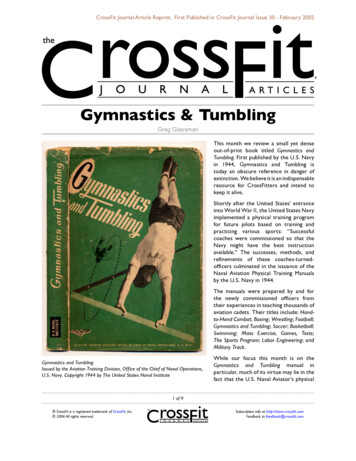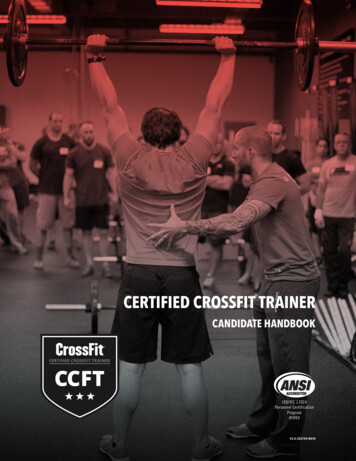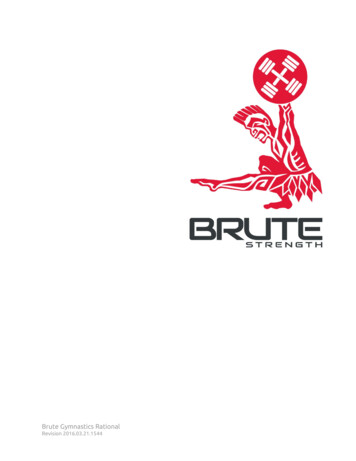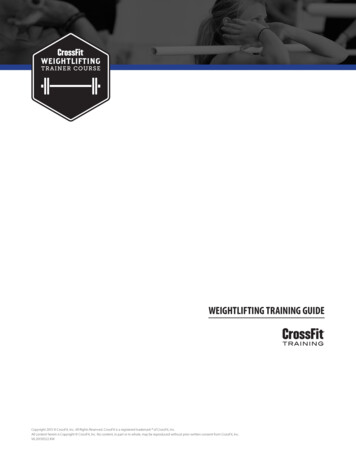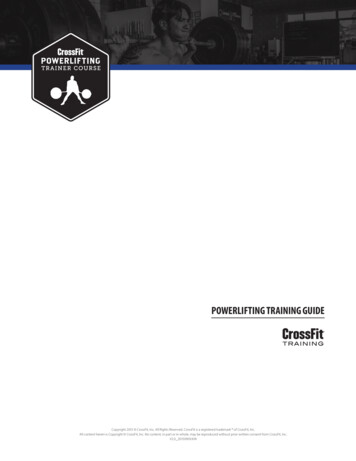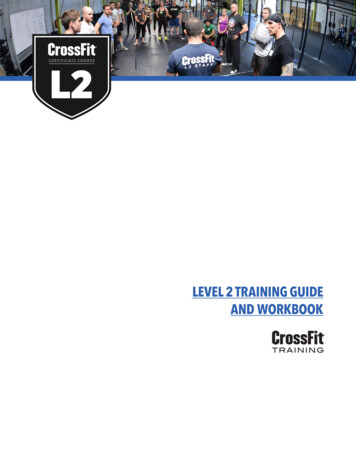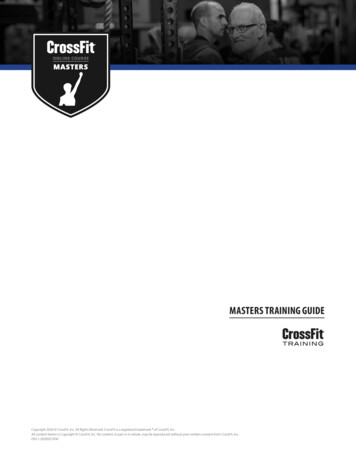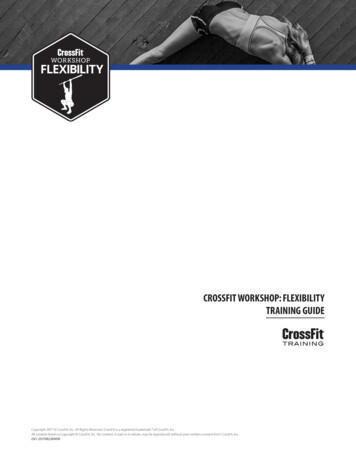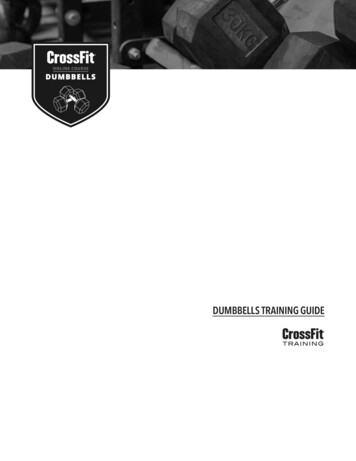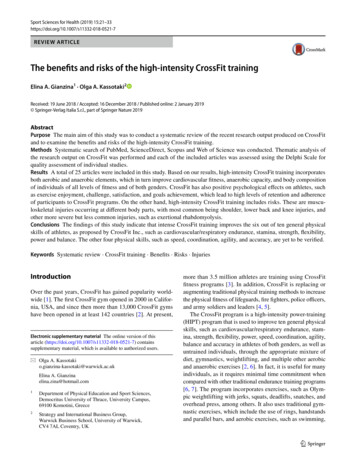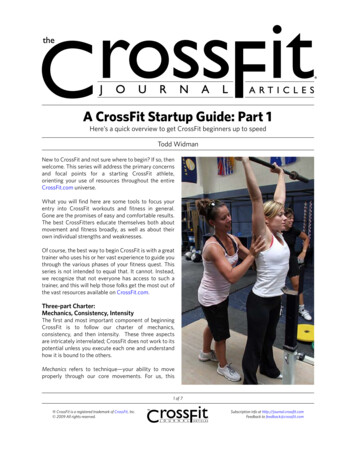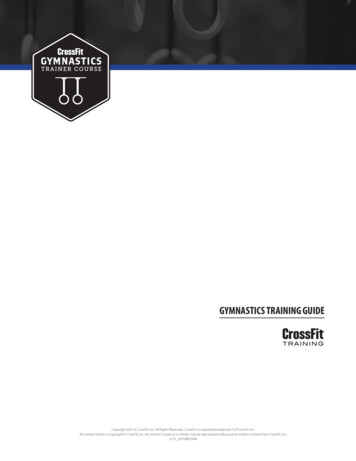
Transcription
GYMNASTICS TRAINING GUIDECopyright 2015 CrossFit, Inc. All Rights Reserved. CrossFit is a registered trademark of CrossFit, Inc.All content herein is Copyright CrossFit, Inc. No content, in part or in whole, may be reproduced without prior written consent from CrossFit, Inc.V.3.0 20150809.KW
Gymnastics Training Guide TABLE OF CONTENTSCOURSE OVERVIEW. . . . . . . . . . . . . . . . . . . . . . . . . . . . . . . . . . . . . . . . . . . . . . . . . . . . . . . . . . . 3WHAT IS GYMNASTICS? . . . . . . . . . . . . . . . . . . . . . . . . . . . . . . . . . . . . . . . . . . . . . . . . . . . 4WHY DO WE DO IT?. . . . . . . . . . . . . . . . . . . . . . . . . . . . . . . . . . . . . . . . . . . . . . . . . . . . . . . . 6CROSSFIT GYMNASTICS TERMINOLOGY. . . . . . . . . . . . . . . . . . . . . . . . . . . . . . . . . . . 8UNDERSTANDING SKILL PROGRESSION. . . . . . . . . . . . . . . . . . . . . . . . . . . . . . . . . . . . . . . 9SPOTTING. . . . . . . . . . . . . . . . . . . . . . . . . . . . . . . . . . . . . . . . . . . . . . . . . . . . . . . . . . . . . . . . . . . 10WHY DO WE SPOT?. . . . . . . . . . . . . . . . . . . . . . . . . . . . . . . . . . . . . . . . . . . . . . . . . . . . . . . 10WHAT TO LOOK FOR WHILE SPOTTING . . . . . . . . . . . . . . . . . . . . . . . . . . . . . . . . . . . 10GRIP. . . . . . . . . . . . . . . . . . . . . . . . . . . . . . . . . . . . . . . . . . . . . . . . . . . . . . . . . . . . . . . . . . . . . . . . . 11SHOULDERS. . . . . . . . . . . . . . . . . . . . . . . . . . . . . . . . . . . . . . . . . . . . . . . . . . . . . . . . . . . . . . . . . 13COURSE MOVEMENTS . . . . . . . . . . . . . . . . . . . . . . . . . . . . . . . . . . . . . . . . . . . . . . . . . . . . . . . 15HOLLOW AND ARCH POSITIONS . . . . . . . . . . . . . . . . . . . . . . . . . . . . . . . . . . . . . . . . . 15PULL-UP . . . . . . . . . . . . . . . . . . . . . . . . . . . . . . . . . . . . . . . . . . . . . . . . . . . . . . . . . . . . . . . . . 17KNEE-TO-ELBOW AND TOE-TO-BAR . . . . . . . . . . . . . . . . . . . . . . . . . . . . . . . . . . . . . . 19BALL-UP . . . . . . . . . . . . . . . . . . . . . . . . . . . . . . . . . . . . . . . . . . . . . . . . . . . . . . . . . . . . . . . . . 21PASS THROUGH. . . . . . . . . . . . . . . . . . . . . . . . . . . . . . . . . . . . . . . . . . . . . . . . . . . . . . . . . 22FRONT LEVER . . . . . . . . . . . . . . . . . . . . . . . . . . . . . . . . . . . . . . . . . . . . . . . . . . . . . . . . . . . 22BACK LEVER. . . . . . . . . . . . . . . . . . . . . . . . . . . . . . . . . . . . . . . . . . . . . . . . . . . . . . . . . . . . . 23RING SUPPORT. . . . . . . . . . . . . . . . . . . . . . . . . . . . . . . . . . . . . . . . . . . . . . . . . . . . . . . . . . . 24IRON-CROSS . . . . . . . . . . . . . . . . . . . . . . . . . . . . . . . . . . . . . . . . . . . . . . . . . . . . . . . . . . . . . 24DIP. . . . . . . . . . . . . . . . . . . . . . . . . . . . . . . . . . . . . . . . . . . . . . . . . . . . . . . . . . . . . . . . . . . . . . 25MUSCLE-UP. . . . . . . . . . . . . . . . . . . . . . . . . . . . . . . . . . . . . . . . . . . . . . . . . . . . . . . . . . . . . 26PISTOLS. . . . . . . . . . . . . . . . . . . . . . . . . . . . . . . . . . . . . . . . . . . . . . . . . . . . . . . . . . . . . . . . . 29HANDSTANDS. . . . . . . . . . . . . . . . . . . . . . . . . . . . . . . . . . . . . . . . . . . . . . . . . . . . . . . . . . . . 31HANDSTAND PUSH-UP. . . . . . . . . . . . . . . . . . . . . . . . . . . . . . . . . . . . . . . . . . . . . . . . . . . 33HANDSTAND WALK . . . . . . . . . . . . . . . . . . . . . . . . . . . . . . . . . . . . . . . . . . . . . . . . . . . . . . 33HEADSTAND . . . . . . . . . . . . . . . . . . . . . . . . . . . . . . . . . . . . . . . . . . . . . . . . . . . . . . . . . . . . 34HAND BALANCE. . . . . . . . . . . . . . . . . . . . . . . . . . . . . . . . . . . . . . . . . . . . . . . . . . . . . . . . . 34PARALLETTES. . . . . . . . . . . . . . . . . . . . . . . . . . . . . . . . . . . . . . . . . . . . . . . . . . . . . . . . . . . . 35RING AUXILIARY DRILLS . . . . . . . . . . . . . . . . . . . . . . . . . . . . . . . . . . . . . . . . . . . . . . . . 36PROGRAMMING. . . . . . . . . . . . . . . . . . . . . . . . . . . . . . . . . . . . . . . . . . . . . . . . . . . . . . . . . . . . . 37GYMNASTICS & TUMBLING . . . . . . . . . . . . . . . . . . . . . . . . . . . . . . . . . . . . . . . . . . . . . . . . . . 41A MESSAGE FROM TUCKER . . . . . . . . . . . . . . . . . . . . . . . . . . . . . . . . . . . . . . . . . . . . . . . . . . 512 of 53Copyright 2015 CrossFit, Inc. All Rights Reserved.V.3.0 20150809.KW
Gymnastics Training Guide COURSE OVERVIEWThe CrossFit Gymnastics course was developed by Coach Jeff Tucker and is taught by histeam of instructors. The goal is to empower you as a coach and student of gymnastics.The seminar is designed to educate coaches about basic gymnastics movements.Understanding and practice of these movements with proper form undoubtedly helpsathletes progress and improve their general physical preparedness.Athletes have different goals. For some, the goal is to live a more comfortable and healthier life. Others might have jobs in which their lives and the lives of others depend on theirphysical abilities. Some athletes simply want to dominate workouts. Regardless of thegoal, the skills, drills, and concepts in this course, basic or otherwise, allow all athletes toimprove in a safe and effective manner.We want and expect coaches to become very comfortable with a variety of movements.We want them to understand how to break them down, to see and correct movementfaults, and to be able to use a variety of spotting techniques.We encourage coaches to keep an open mind, ask questions, and approach the weekendwith an adventurous attitude.3 of 53Copyright 2015 CrossFit, Inc. All Rights Reserved.V.3.0 20150809.KW
Gymnastics Training Guide COURSE OVERVIEWWHAT IS GYMNASTICS?TYPES OF GYMNASTICSThere are many types of gymnastics, with artistic gymnastics being the classic style seenat the Olympics. Women contest four events: vault, uneven bars, beam, and floor. Mencontest six events: vault, high bar, pommels, rings, parallel bars, and floor.Body-weight movements. Done with or without apparatus.Another gymnastics genre is acrobatic gymnastics. More people understand this as the“crazy stuff” seen in Cirque du Soleil and other similar shows. Trapeze, straps or ribbons,random balancing acts, and trampolines are just some of the elements in acrobatic gymnastics. Rhythmic gymnastics use items including ribbons, batons, balls, and hoops.Gymnastics movements can also be found in other places: the sport has influence onvarious types of stunt work used in movies or various live shows.BRIEF HISTORYThe origin of gymnastics dates back to antiquity. The Greeks and Romans were proponents of gymnastics and used gymnastics training to prepare their military forces for thephysical demands of combat. For instance, gymnastics can help a soldier master skills suchas mounting and dismounting horses. In addition to military training, gymnastics movements were used to provide entertainment.Modern gymnastics appeared in the 18th century, when two physical educators decidedto create apparatus such as the high bar and parallel bars (originally fashioned from aladder with the rungs removed). A pommel was turned sideways and the handles wereremoved to create the apparatus needed to vault.4 of 53Copyright 2015 CrossFit, Inc. All Rights Reserved.V.3.0 20150809.KW
Gymnastics Training Guide COURSE OVERVIEWMen’s gymnastics was eventually accepted into the modern Olympic Games in 1896, andwomen were welcomed in 1928.The U.S. Navy adopted gymnastics in 1942 as a way to make naval aviators fearless andto give them better spatial awareness. The 101st Airborne Division of the U.S. Army laterused the Navy’s guide to gymnastics and tumbling in order to develop agility, balance,strength, and confidence in soldiers.When CrossFit Founder and CEO Greg Glassman reintroduced this piece of literature tothe public in the February 2005 CrossFit Journal article “Gymnastics and Tumbling,”copies were difficult to find, so the entire guide was scanned and made available to thecommunity. It can be found later in this document.WHAT IS CROSSFIT GYMNASTICS?In CrossFit, body-weight movements are considered gymnastics (e.g., air squat, push-up,pull-up, etc.). We are taking skills from the sport of gymnastics and applying them toworkouts. In CrossFit, the gymnastics label is applied any exercise in which you move yourbody through a range of motion (ROM) or extended range of motion (EROM) without anexternal load. Isometric holds are also considered gymnastics.CrossFit uses short parallel bars (“parallettes”), the floor, still rings, pull-up bars, dip bars,climbing ropes, and other equipment to implement gymnastics training.Gymnastics establishes functional capacity for body controland range of motion.5 of 53Copyright 2015 CrossFit, Inc. All Rights Reserved.V.3.0 20150809.KW
Gymnastics Training Guide COURSE OVERVIEWWHY DO WE DO IT?Gymnastics is one of the three foundational modalities ofCrossFit. If gymnastics movements are performed properly, theyinfluence every aspect of your life and have a dramatic effect onyour fitness. Gymnastics assist in development of many of the 10components of fitness: accuracy, agility, balance, coordination,cardiovascular endurance, flexibility, power, speed, strength,and stamina. Nothing beats gymnastics in terms of developing the four neurological components of the 10: coordination,agility, balance, and accuracy. Furthermore, gymnastics trainingproduces impressive strength gains without requiring an external load.Gymnastics is a cornerstone of CrossFit, along with weightlifting and monostructural metabolic-conditioning (or just“monostructural”) movements. It is an essential element in theTheoretical Hierarchy of Development of an athlete, the CrossFit“pyramid” (see “What Is Fitness?”). The hierarchy reflectsfoundational dependency and time ordering of development asfollows: nutrition, cardiovascular efficiency, body control, external-object control, and sport-specific application. According tothe hierarchy, you can only maximize competency in one category if you have laid the foundation in the category before it.This hierarchy puts a larger emphasis on gymnastics proficiency– body control – before weight training and sport.6 of 53Copyright 2015 CrossFit, Inc. All Rights Reserved.V.3.0 20150809.KWDEFINITIONS FOR GYMNASTICSFrom Thefreedictionary.comUsed with a plural verb: Physical exercises usedto develop and display strength, balance, andagility. Especially those performed on or withapparatus.Used with a singular verb: The art or practiceof such exercise.GYMNASTICSOur use of the term “gymnastics” not onlyincludes the competitive Olympic sport butalso activities in which the aim is body control—climbing, yoga, calisthenics, and dance,for example.
Gymnastics Training Guide COURSE OVERVIEWStrength is required for proper form, and proper form is required to demonstrate bodycontrol. As such, gymnastics has a clear emphasis on strength in body-weight movements. More than anything else, strict form establishes mastery in a movement, and forthis reason we promote strict movement before we apply momentum. The strength gainsfrom mastering the strict movements are well worth the effort, and the possibility ofinjury is reduced substantially when strict movements are practiced first. Small moves willbring great rewards. You do not rush these movements. You learn them and earn them!7 of 53Copyright 2015 CrossFit, Inc. All Rights Reserved.V.3.0 20150809.KW
Gymnastics Training Guide COURSE OVERVIEWCROSSFIT GYMNASTICS TERMINOLOGYActive Tissue Muscles that do work even during transitionalmovement.Hollow A position used to create stability, characterized bystrong midline contraction with active tissue fromtoes to fingers.Strict Movement absent a kip. The athlete relies on musclecontrol and strength to complete the movement.Kip A dynamic movement from a lower plane to ahigher plane.Load The forces created while body weight is in motion.Core Musculature that ranges from the top of the glutesup to the traps, including the front, back, and sides ofthe torso but excluding the extremities.Form The manner or method o
the public in the February 2005 CrossFit Journal article “Gymnastics and Tumbling,” copies were difficult to find, so the entire guide was scanned and made available to the community. It can be found later in this document. WHAT IS CROSSFIT GYMNASTICS? In CrossFit, body-weight movements are considered gymnastics (e.g., air squat, push-up,
